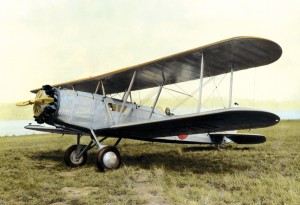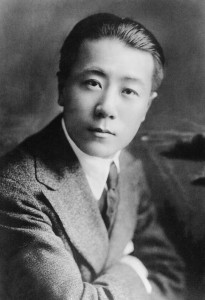By Candice Tewell
The story of aviation in the Northwest—indeed the story of the Northwest itself—is inextricably linked to the story of The Boeing Company. This one company has arguably shaped the growth of the Puget Sound area more than the comparatively recent additions of Microsoft, Starbucks and all others combined.

The Boeing Model 40 featured an open cockpit for the pilot and a small enclosed cabin for two passengers, whose fares allowed the airplane to be more competitive than other mail planes of the day.
After all, it was Boeing layoffs in the early seventies that emptied Seattle to such an extent that someone bought a billboard in order to share the sentiment, “Will the last person to leave Seattle please turn off the lights?” The Museum of Flight has designed a new permanent exhibit, opening June 18, that explores in depth the formative years of the aerospace giant and its intimate relationship with Northwest history.
What better place to honor Boeing than in the company’s birthplace, the William E. Boeing Red Barn. The Red Barn has seen a lot of changes over the years. When young Seattle timber baron Bill Boeing bought it in 1909 from struggling shipbuilder Edward Heath for “$10 and other considerations,” he did so to ensure completion of his personal yacht, the “Taconite.” Later, in 1916, after the flying bug had bitten Boeing, he headquartered his new company, Pacific Aero Products, in the barn and began building airplanes there. Later, Boeing Airplane Co. President Clairmont Egtvedt oversaw the design of the B-17 from his office in the Red Barn, and in 1975, this historic structure boarded a barge for its mile-and-a-half journey up the Duwamish River to Boeing Field, where it became the first permanent home of the fledging Museum of Flight, opening to the public in 1983.
Now the Red Barn is seeing more change, as museum staff members tackle a complete revamp of the displays on the first floor. The new exhibits will focus on the life of William E. Boeing and the first two pioneering decades of the Boeing Airplane Co. The story begins with Boeing’s family and early life, and then moves on to his introduction to the new world of aviation and his move to the Seattle area. Visitors will encounter many new stories about the man who built one of America’s most important companies, including insight into his personal motivations and the many challenges he faced on his road to success.
Rare loaned artifacts from The Boeing Company archives and from Boeing’s son and museum trustee, William E. Boeing Jr., will be displayed alongside treasures from the museum’s own collection. Some highlights will include the famous mail bag carried in 1919 by Boeing Sr. and Eddie Hubbard during the first international U.S. Air Mail flight from Vancouver, B.C., to Seattle. Also on display for the first time ever will be a small wooden fragment—the only piece known to exist—of one of Boeing’s first two aircraft, the commercially unsuccessful B&W floatplane.
A little-known story highlighted in the new exhibit will be that of Wong Tsu. This Chinese immigrant was one of the very first Boeing employees, hired in 1916 to design and build Boeing’s first commercially successful aircraft, the Model C. At the time of his hiring, Wong was one of only a handful of degreed aeronautical engineers in the country. He later returned to China, where he’s revered for his work in establishing the Chinese aviation industry. The exhibit will display early company ledgers showing Wong’s addition to the payroll.
The exhibit storyline ends with the government’s 1934 antitrust breakup of United Aircraft and Transport Corporation, a conglomerate made up of the Boeing Airplane Co., Boeing Air Transport, Pratt & Whitney and several other aircraft manufacturers and small airlines. The forced breakup seems to have sapped William Boeing’s spirit, and his retirement from the company and the industry took place very shortly afterwards.

Boeing hired Wong Tsu, one of the nation’s few aeronautical engineers, in 1916. He designed Boeing’s first financially successful airplane, the Model C, among other aircraft.
A large portion of the new Red Barn exhibit will recreate the original active shop floor that once filled the building. Two eras will be represented. A circa-1917 shop will feature the all-wood fuselage of a Model C floatplane reproduced by a team of craftspeople at Century Aviation in East Wenatchee, Wash. The Model C was Boeing’s first aircraft designed wholly in-house, the first for which the fledgling company received a large-scale production order, and its first financial success. In all, 56 Model Cs were built—all in the Red Barn—but the last of them was destroyed in spectacular fashion in 1938. The movie “The Dawn Patrol,” starring Errol Flynn and David Niven, featured several “German” biplanes being shot down. Dennis Parks, Museum of Flight senior curator, who watched the sequence frame by frame, confirms that the planes being dispatched were actually the last remaining Model Cs.
Century Aviation thus undertook the task of reconstructing a 1917 aircraft without detailed engineering drawings, using historic photographs and the design details of other Boeing aircraft as clues in a game of historical aircraft sleuthing. The completed fuselage, 22 feet long, two and a half feet wide and five feet high, has been trucked to the museum, where it will hold a place of honor, back on the Boeing shop floor.
Museum volunteers have also welded an authentic steel-tube Model 40 fuselage that will join the Model C in the exhibit, representing the second decade of Red Barn activity. Designed in 1925, the Model 40 was the first Boeing plane designed to carry passengers. Conceived from the outset as a mail plane, Boeing fitted a cramped passenger cabin for two as a way of generating revenue to offset operating costs and thereby allow more competitive mail contract bidding. The gambit worked, and more than 20 Model 40s were built.
Surrounding the Model C and Model 40 fuselages in the new Red Barn exhibit will be the tools of the trade for airplane building in the early twentieth century—woodworking machinery, lumber, benches and hand tools, welding gear, carts and other workshop materials.

L to R: Eddie Hubbard and William Boeing with the Model C on the shores of Seattle’s Lake Union following completion of the first international airmail flight, March 3, 1919. The mailbag Boeing is holding will be on display in the new Boeing exhibit.
The exhibit will also address the other non-Boeing people, issues, organizations and companies that played important parts in the vibrant Northwest aviation industry during the time that Boeing became an established airplane company. There’s no better place to explore the birth of one of the Northwest’s most important industries than in its birthplace. Come down beginning June 18 to experience the early Boeing story—the latest chapter in the Red Barn’s constant evolution—for yourself.
For more information, visit [http://www.museumofflight.org].











